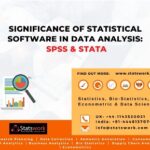The theory of multilevel models and present applications of multilevel models as well as software for fitting such models
In-Brief:
- Multilevel model notes the existence of hierarchies’ study by allowing residual components at each level of the hierarchy.
- Multilevel modelling is an approach used to handle clustered or grouped data.
- Multilevel models analyze data that are with repeated with measurements or data organized in nested level
Data is collected from Data collection services. It has either of the primary or secondary types,which hasenormous variationsthat include hierarchical or clustered structured. Outsourcing data collection and business services are collected information in many sources and having hugevariables or factors why because they used information for many purposes. They need a highly reliable statistical tool to analyze such existing data sets. Researcher or business developers wants to know the relationship between these variables and which factors are most effective for business development. In Statistical analysis, there are various ways available to analyze or summarize the data according to the customer or objective of the study.
Introduction
Multilevel models are the one way to identify the relationship between more than one variable and also used for prediction of the dependent variables.Multilevel models are a generalization of linear effect and linear mixed models like random effect, random parameter, split-plot designs are used in statistical analysis. Multilevel models are having few assumptions like linearity, normality, homoscedasticity(homogeneity of variance), independence of variables. When the data is hierarchical, then these assumptions may differ slightly. In the case of hierarchical data, linearity is rectilinear means non-linear. Present these models are extended to non-linear models also. Some cases, different- correlation matrix can be noted, and variation in the variance also be modelled.
Application of multilevel model
Multilevel models are applied to deal with clustered or grouped data.These models have wide applications in research as well as the project to perform in groups, between groups of the particular purpose. The researchers want to plan more than one level; then, these models are very appropriate. Generally, analysis units are at a low level, and contextual or aggregate units are at a high level. At the same time, repeated measured data analysis also examined by using an alternative type of analysis like the univariate or multivariate analysis. Simple linear regression analysis considers units of analysis as an independent variable; this will affect the statistical significance and predicted variable. It may lead to false conclusions.
Many kinds of research involve the amount of grouping in individual product and framing the main groups. Also for estimating group affects along with the predictors. Because of these reasons, multilevel models are used. The researcher must choose various aspects before performing multilevel models which includes a selection of predictor variable, and parameter values mean estimated elements are random or fixed. Specification of predictive variables from multiple levels, including variables and key interactions, are called fixed-effect models. Specification of correlation within responses from the same clusters is called random effect models. If it is the random parameters, then it has different values for each of the groups. Also, determine the maximum likelihood estimation.
The final base choiceentirely relies on the research questions understanding and empirical evidence. These models are applicable where the researcher handled more than one factors influencing a particular object. Market research data collection and analysis for companies use multilevel models to know the various factors affecting the business.
It is also applicable in education, psychological, social and geographical research to estimate the variance within the individual as well as between groups. Especially in the field of the health care market researchare potential benefits by using these multilevel models. By applying in the educational research will find more improvementin methodologies.
 |  |
|---|
Software fixing multilevel model
The present market scenario laid on software to analyze any data write from the questionnaire, Data cleaning & analysis and final interpretation. Simple statistical methods like time series, multiple regression analysis, factor analysis, data cleaning SPSS software is sufficient. Whereas for the model building, we need programs. Generally, these programs are used for multilevel models by considering, or sometimes the researcher may modify the program according to their objects. Nowadays, there are online statistics works helpful.
There is plenty of software available for model fitting. Market research data collection services depend on software packages like,
- aML
- GENSTAT
- HLM
- SAS
- S-Plus
- SPSS
- Stata
- Python
- Win BUGS
Besides this, all the available software has its strengths and weaknesses. It’s all depends on the researcher or reviewer choice to select which software. Many Research data collection services or outsource data collection services are compared to the results of multilevel models by using different software packages. All produce more or less similar results that are checked by considering the p-values, estimates and standard errors. Especially software of SAS, HLM, R, and SPSS.The differences they find when there is a change from fixed to random effect.
Most of the packages are developed by individual PhD dissertation. Later they may convert it into a commercial product or user friendly. It is more important to know the coding and programming for any software so that an analyst can easily interpret the results.These days everyone depends on online services for all their works.Many Data mining services techniques are collecting information from various sources. Between the groups, then he may apply multilevel models to extract the facts insight the information.Outcomes of the multilevel models are more reliable and accurate in prediction than the simple regression analysis. It is also helpful in the testing of hypotheses about the variation of treatment effects across the subgroups. It acts as statistical power through flexibility and convenience model to fit for multiple variables. More broadly, multilevel refer to the qualitatively various levels of diversity.
E.g. society, groups, individuals, cells, genes, etc., are important to know the actual disease. In this case, multilevel models are appropriate to describe, summarize and quantify the pattern present in the data.A few drawbacks of the multilevel models noted that generalization of the average treatment effect, interpretation of the estimated treatment effects. Finally, inference of a statistical in groups depends on the number of groups and the way they design the groups.
Conclusion
Therefore, it is more heterogeneous, and a large amount of data is handling for different purposes. From this huge data set, it is needed to select reliable information according to their purposes. In this process, the analyst may handle multiple factors to know the relationship within variables.
References
1. Goldstei, H. (1999). Multilevel Statistical Models.
2. Kreft, J. D. L. and I. G. G. (1998). Software for Multilevel Analysis.



 Previous Post
Previous Post Next Post
Next Post